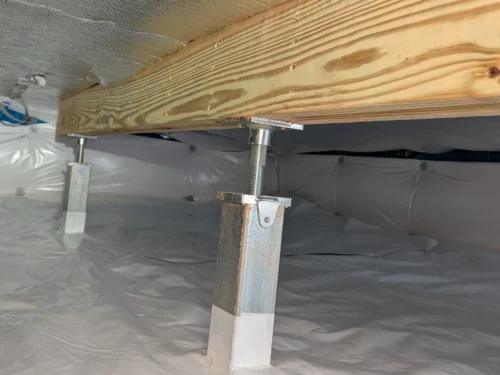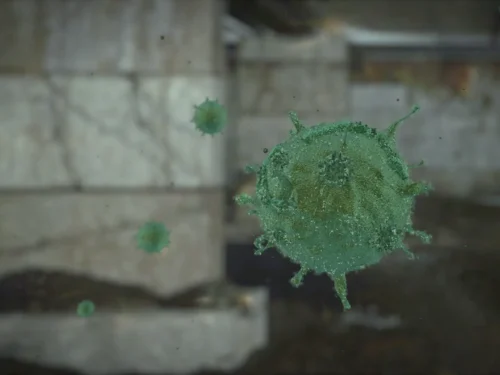Have you ever walked into your home after a long day, only to notice a faint musty smell you can’t place? Or maybe your hardwood floors feel colder than they should in winter, even though your heating system is running. Maybe your energy bills seem to climb every season, and you can’t quite figure out why.
Most people look to their windows, their roof, or their insulation in the attic when they see these problems. But, in many homes, the real culprit sits in a place we almost never think about — the crawl space.
Especially if your crawl space has a dirt floor, it can quietly work against you every single day. Moisture seeps upward. Air from below mixes with the air you breathe. Pests find a perfect hiding spot. All the while, your home’s efficiency and comfort suffer.
That’s where a vapor barrier insulating crawl space with a dirt floor comes in. Let’s look at why it works and how it can protect your home for years to come.
The Hidden Role of Your Crawl Space
Most homeowners rarely think about the space under their house. But your crawl space has a big impact on how your home feels and functions. Studies show that more than 50% of the air in your living areas comes directly from the crawl space.
That means whatever is happening down there — moisture, mold, pests, or cold air — will travel upward into the rooms where your family eats, sleeps, and breathes.
For homes with a dirt floor crawl space, this is even more important. Dirt is not a sealed surface. It constantly releases water vapor into the air. Without protection, that moisture spreads into your crawl space and your home.
Since so much of the air you breathe comes from your crawl space, the conditions of your crawl space can directly impact your health. In fact, poor crawl space air has been linked to allergy symptoms too, read our blog to know how your crawl space could be to blame for spring allergies
Why Dirt Floors Make Crawl Spaces Risky
A dirt crawl space may look harmless, but it creates several serious issues. Let’s break them down.
Continuous Moisture Source
Soil naturally holds and releases water. In a crawl space, this means constant evaporation. The moisture doesn’t stay trapped — it rises into the air, creating a damp environment that encourages mold growth, wood rot, and even rust on metal pipes or ducts.
Energy Inefficiency
When the floor is exposed dirt and the walls are uninsulated, your crawl space acts like an open window. Cold winter air chills your floors, and humid summer air adds strain to your cooling system which results in higher energy bills and less comfort.
Pest Attraction
A dark, damp crawl space is the perfect invitation for rodents, termites, and insects. Once pests move in, they can chew through insulation, wiring, and even wood framing.
These problems don’t stay contained under your home — they spread upward, affecting indoor air quality, energy use, and long-term home value.

The Solution: Vapor Barrier Insulating Crawl Space with Dirt Floor
The best first step to solving crawl space problems is installing a dirt floor crawl space vapor barrier.
A vapor barrier is a thick plastic sheet that covers the ground and is sealed to the walls. It separates the soil from the air in your crawl space, blocking water vapor from rising.
Think of it as putting a shield between your home and the damp ground beneath it. By controlling moisture at the source, you create a crawl space environment that is dry, stable, and ready for proper insulation.
Step-by-Step: Insulating Crawl Space with Dirt Floor
Moisture control and insulation work together. Here’s the process professionals use to make a crawl space energy-efficient and safe.
Step 1: Seal Crawl Space Vents
Many older homes have open vents in the crawl space. While they were once believed to improve airflow, research shows they actually let in humid summer air and freezing winter air. The first step is to seal them.
Step 2: Install a Vapor Barrier
Next comes the vapor barrier insulating crawl space with dirt floor. The barrier is rolled out over the entire dirt surface, sealed tightly, and extended up the walls. High-quality crawl space vapor barrier material is tough enough to resist tearing and designed to last for decades.
Step 3: Add Insulation to Walls and Rim Joists
Once moisture is controlled, it’s time to insulate. The best insulation for crawl space is rigid foam board. It resists water, delivers a high R-value (thermal resistance), and won’t sag like fiberglass. Foam insulation is installed along the walls and rim joists to keep outside temperatures from affecting your floors above.
Step 4: Consider Full Encapsulation
Encapsulation takes things further by sealing the crawl space completely — vapor barrier on the floor and walls, insulated surfaces, and sometimes a dehumidifier. This creates a controlled indoor-like environment that protects your home year-round.
Step 5: Add Drainage or Dehumidification if Needed
For homes in areas with heavy rain or groundwater issues, adding a sump pump or dehumidifier ensures the space stays dry and stable. This completes the system and prevents future problems.
Benefits of Crawl Space Vapor Barrier Material
When you install a vapor barrier and insulation correctly, the benefits reach every part of your home.
Cleaner, Healthier Air
Since so much of your indoor air comes from your crawl space, a crawl space moisture barrier reduces mold spores, dust, and allergens. Families often notice fresher air and fewer musty odors once the barrier is in place.
Energy Savings
By stopping heat loss and blocking humid air, insulation helps your system run more efficiently. Many homeowners notice their heating and cooling bills drop once the crawl space is sealed. Over time, that savings adds up, which means the investment keeps paying you back year after year.
Stronger Structure
Moisture doesn’t just affect air — it weakens wood beams and can crack foundations over time. Keeping your crawl space dry protects the core structure of your home and avoids costly future repairs.
Common Misconceptions About Crawl Spaces
There are a few myths that cause homeowners to delay taking action. Here’s the truth.
- “Crawl space vents are necessary.” Actually, vents invite outdoor air that makes problems worse. Sealing them is better.
- “Fiberglass is fine for insulation.” Fiberglass absorbs water and becomes useless in damp conditions. Rigid foam board is the real best insulation for crawl space.
- “A vapor barrier alone is enough.” While a barrier is critical, insulation is also needed to improve comfort and energy savings.
Dirt Crawl Space Solutions That Work
When comparing dirt crawl space solutions, the difference is clear.
- Doing nothing allows moisture, pests, and energy loss to continue.
- A quick DIY fix often doesn’t address underlying issues.
- Installing a professional-grade dirt floor crawl space vapor barrier with insulation delivers long-lasting protection.
This solution turns a vulnerable area of your home into a protective layer that improves comfort, safety, and efficiency.
When to Call a Professional
Not every crawl space is easy to handle on your own. Uneven floors, tight access, or existing mold can make DIY unsafe or ineffective. Here are signs it’s time to call an expert:
- Musty smells inside the home.
- Rising energy bills with no clear cause.
- Floors that feel cold or damp.
- Visible mold, mildew, or standing water.
- Evidence of pests in the crawl space.
A professional can evaluate your crawl space, recommend the right crawl space vapor barrier material, and make sure the job is done correctly for long-term results.
Ready to Protect Your Home?
Your crawl space might not be a place you spend much time in, but it affects your daily life more than you realize. From the air you breathe to the money you spend on heating and cooling, everything ties back to what’s happening under your home.
But, you don’t have to live with musty odors, damp floors, or rising energy costs. By installing a dirt floor crawl space vapor barrier and pairing it with the right insulation, you can create a healthier, safer, and more efficient home.
If you’re in Virginia Beach and want to finally solve what’s going on beneath your house, our team can help. We’ll inspect your crawl space, explain what we find, and recommend the right crawl space vapor barrier material so you get lasting results.
Contact us today to book your inspection and see how much difference a protected crawl space can make.
Frequently Asked Questions
What is a vapor barrier and why is it important for crawl spaces with dirt floors?
A vapor barrier is a thick plastic sheet installed over the dirt floor of your crawl space. Its main job is to block moisture from evaporating up into your crawl space, preventing mold, wood rot, and poor indoor air quality.
Can I install a vapor barrier myself, or should I hire a professional?
While some homeowners attempt DIY installation, it’s best to consult a professional—especially if your crawl space has uneven floors, tight access, or existing moisture issues. Professionals ensure the barrier is properly sealed and recommend the right materials for long-term protection.
Is a vapor barrier enough, or do I also need insulation?
A vapor barrier is essential for moisture control, but insulation is also needed to improve energy efficiency and comfort. Rigid foam board insulation on crawl space walls and rim joists works best, as it resists moisture and keeps your floors warmer.
What are the signs that my crawl space needs a vapor barrier?
Common signs include musty odors, cold or damp floors, visible mold or mildew, high energy bills, and pest infestations. If you notice any of these, it’s time to inspect your crawl space.
How long does a vapor barrier last?
High-quality vapor barriers are designed to last for decades when installed correctly. Regular inspections help ensure ongoing protection.
Will a vapor barrier help with pest problems?
Yes. By reducing moisture and sealing gaps, a vapor barrier makes your crawl space less attractive to pests like rodents and insects.
What’s the difference between a vapor barrier and encapsulation?
A vapor barrier covers just the floor, while encapsulation involves sealing the floor, walls, and sometimes adding a dehumidifier. Encapsulation creates a fully controlled, dry environment for maximum protection.
How much does it cost to install a vapor barrier in a crawl space?
Costs vary depending on the size and condition of your crawl space, as well as whether you add insulation or drainage systems. A professional inspection can provide a detailed estimate.








